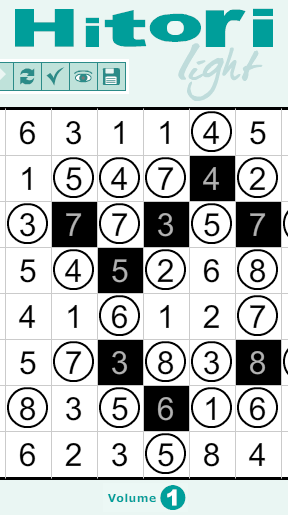
![]() Let's see... if I shaded in that 4, I'd have to circle the 2 next to it, which would in turn mean I'd have to shade the other 2 next to that. That's a no-no because it and the 4 would isolate the circled 2, so the 4 must be circled. Circling that 4 means the 4 down there has to be shaded, so I'll circle the... phew, I'd better take a break. The latest Conceptis Light puzzle suite, Hitori Light, certainly is a mind-bender.
Let's see... if I shaded in that 4, I'd have to circle the 2 next to it, which would in turn mean I'd have to shade the other 2 next to that. That's a no-no because it and the 4 would isolate the circled 2, so the 4 must be circled. Circling that 4 means the 4 down there has to be shaded, so I'll circle the... phew, I'd better take a break. The latest Conceptis Light puzzle suite, Hitori Light, certainly is a mind-bender.
- One: no two circled squares with matching digits may exist in the same row or column.
- Two: no two shaded squares may be directly adjacent to one another (touching corners doesn't count).
- And three: no circled square or group thereof may be completely isolated from the rest by shaded squares (again, touching corners doesn't count).
It takes a very particular kind of mind to come up with the genius puzzles given such a seemingly arbitrary set of rules, a kind of mind many just don't have (*achoo!*), but there must be at least half a dozen such minds working at Conceptis to come up with a whopping 30 puzzles across three grid sizes, to say nothing of their previous Light projects like Nurikabe Light and Sym-a-Pix Light. Each puzzle is fairly entertaining and has its own unique solution, and it's easy to start formulating strategies based on specific patterns of numbers that turn up often (for example, what does it mean when you see three of a number consecutively in a row or column?).
Looking for a mind-bending distraction for a few minutes of your time? Then come shade and circle some squares. I know I am.





Walkthrough Guide
(Please allow page to fully load for spoiler tags to be functional.)
Hitori Tips & Strategies
(Note: Rules One, Two, and Three are as numbered in the review.)
Common Formations and What They Mean
The Double: If two identically numbered squares are directly adjacent, one is circled and one is shaded. This is because having both circled would violate Rule One, and having both shaded would violate Rule Two.
The Sandwich: If a square is sandwiched between two other squares that are identically numbered to one another (but not necessarily the one in between) along a row or column, the square in the middle is circled. This is because by Rule One, one or both of the outer squares must be shaded, and no matter how this is done, Rule Two would force the middle square to be circled.
The Double-Single: If there are three identically numbered squares in a row or column (not necessarily adjacent), and two of them form The Double, the third is definitely shaded. This is because we know from its logic above that one of the two squares in The Double is circled, and no matter which it is, Rule One applies.
The Triple: If three identically numbered squares appear consecutively in a row or column, the one in the middle is circled, and the other two are shaded. Reapplying the logic behind The Double-Single and/or The Sandwich should make it quickly apparent why.
The Corner: If one square in The Double is in a corner or otherwise has only one other non-shaded square adjacent to it, that other adjacent square (the one NOT part of The Double) is definitely circled. Why? If it were shaded, Rule Two would force the cornered square to be circled, and then Rule One would force the remaining square to be shaded. This would leave the cornered square completely trapped by shaded squares, violating Rule Three.
The Gate: If The Sandwich occurs with no other unshaded squares adjacent to the middle square, exactly one of the outer squares must be circled AND the middle square may be treated as shaded when evaluating Rule Three. These are because Rule One dictates that one of the squares must be shaded, and either would put a lid on the bottleneck; also, having both shaded traps the known-to-be-circled middle square, violating Rule Three.
General Advice
Every puzzle has exactly one solution, no more, no less. Never forget that.
Start a puzzle by looking for the formations in the above spoiler, namely The Sandwich, The Double-Single, The Triple, and The Corner. Use the information gleamed from those to start deducing other squares.
When you shade a square, you may immediately circle all the squares adjacent to it, because of Rule Two. Likewise, when you circle a square, you may immediately shade any squares that would violate Rule One if also circled.
Keep an eye out for "bottlenecks", narrow pathways of non-shaded squares that connect otherwise isolated parts of the grid. If blocking a bottleneck with a shaded square causes a Rule Three violation, you know where to place your circles. Remember the clause about evaluating Rule Three on The Gate.
When in doubt, think a few steps ahead. Leave your cursor over a critical-looking square and ask, "What would it imply if I shaded this square?" ("What would it imply if I circled this square?" is typically less useful, mainly because there are two rules by which shaded squares can force circled squares and only one rule vice-versa.)
When REALLY in doubt, take a break and go play something else. If a casual game is getting you wound up, you're doing it backwards.
Posted by: SonicLover |
June 14, 2012 7:26 PM
|
June 14, 2012 7:26 PM